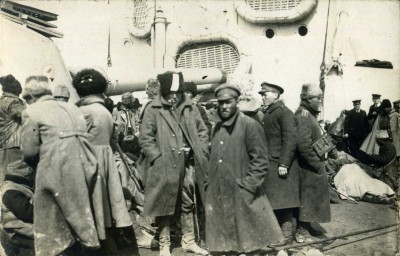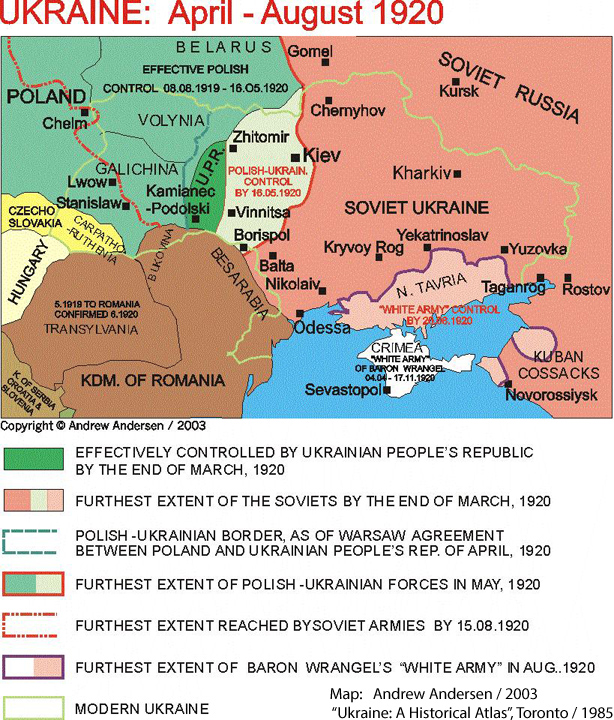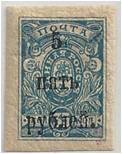ALBUM – view my Crimea under the control of the White Army Album
TRANSITION CHART – Ukraine and South Russia
Fast Facts
Region: Russia Area
Group: Ukraine and South Russia
Classification: Revolutionary Government
Prior Regime:Crimean Border Government followed by a short occupation by the Red Army
Key Dates:
1917, Sept – Bolshevik Government led by Vladimir Lenin established
1918, Apr/May – German offensive took control of Crimea
1918, Jun 25 – Germans establish Crimean Government led by Gen. Maciej Sulkevich
1918, Nov – Germans withdraw from Crimea, Sulkevich government falls
1918, Nov – Crimean Border Government established under Solomon Krym
1919, Apr – Allies withdraw from Crimea, Red Army takes over
1919, Jun – White Army under General Denikin drives out Red Army
1920, Nov – Wrangel evacuates the White Army in Crimea and the Bolsheviks take control
Following Regime:Bolshevik Revolutionary committee government
Scott Catalogue: (South Russia) #53-58
Pick Catalogue: (South Russia) #s420-s440
History

Finally, in March of 1917, the people, fed up with the massive casualties caused by the war, and chronic food shortages within the nation, revolted and forced Tsar Nicholas to abdicate the throne. A provisional government was formed based on democratic principles, but was overthrown a few months later in Sept of 1917 by the Bolshevik movement (the Red Army), led by Vladimir Lenin. This new, government (which became the Russian Soviet Federative Socialist Republic) began a long and bloody campaign to unite the former Russian Empire under the communist banner. Chaos broke out across the country, and in July 1918 the Bolsheviks had the royal family killed to avoid having them serve as a focal point for the anti-Bolshevik movement (the White Army).
Crimea is a large peninsula which sits out in the Black Sea has been for centuries the home of the Crimean Tartars, and was part of the Russian Empire since 1783. By the time of the 1917 Revolution, Crimea was made up of a mixed population including Tartars, Moslems and Kariate Jews. After the October Revolution, the local Tartars proclaimed an independent “Crimean People’s Republic”, but within a few months, it was crushed by the Bolsheviks. Taking advantage of the turmoil in Russia, German forces in the Ukraine took Crimea in Apr/May 1918, and on 25 Jun, 1918 established a Crimean puppet government lead by General Maciej Sulkevich. The region remained under German “protection” until the end of the war.
An anti-Bolshevik government, called the Crimean Border Government was established on 16 Nov, 1918 led by Solomon Krym, Kariate Jew and a former member of the state senate, and had opposed Sulkevich during the occupation. At the defeat of the Germans and Ottomans in the war, Allied forces sailed into the Black Sea taking various strategic ports. The French Navy captured Odessa in south Ukraine, and landed in Sevastopol along with other Crimean ports. Due to the ongoing fighting in Russia, the French withdrew from Sevastopol on 15 Apr 1919, and signed an armistice with the Bolsheviks 3 days later on the 18th. The Red Army took over Crimea within a matter of days and the Crimean Regional Government collapsed. Solomon Krym and his officials evacuated Crimea to France.
 The Red Army victory was short lived as the White Army under General Denikin moved into Crimea and forced the Red Army to flee in June 1919. General Anton Denikin commanded the large White Army which controlled most of the territory in Southern Russia.
The Red Army victory was short lived as the White Army under General Denikin moved into Crimea and forced the Red Army to flee in June 1919. General Anton Denikin commanded the large White Army which controlled most of the territory in Southern Russia.
Denikin had a strong desire to advance to Moscow as quickly as possible, and pushed his troops hard. Unfortunately he made several strategic mistakes in advancing too fast and not creating adequate supply lines. Essentially many of his troops were left to taking supplies from local populations, and soon received the reputation as a band of thieves. Ultimately, Denikin’s over extended White Army suffered a devastating defeat at Orel, south of Moscow in October, 1919. From this point forward, Denikin’s Army slowly retreated south, ultimately consolidating in Crimea.
On 20 Mar 1920, Denikin was forced to resign and leadership of the White Army passed on to Pyotr Nikolayevich Wrangel, a former General under Denikin, who had a major falling out a few months earlier. While General Wrangle attempted to create a stronghold in Crimea and North Tavria while trying to establish a coalition with other Anti-Bolshevik republics, in reality it was too late as the strength and momentum of the Red Army was too great. After several major losses and continued retreat, Wrangle organized a mass evacuation from Crimea rather than leave his men to the wraith of the advancing Communists. In Nov 1920, about 125 ships from the remnants of the Russian Imperial Navy, evacuated tens of thousands of members and family of the former White Army of the South. The ships, known as Wrangel’s fleet, eventually ended up in refugee camps set up in Gallipoli Turkey, Lemnos Greece, Serbia and Tunis Tunisia. Refugees later settled throughout Europe, mostly in France and the Balkans.
Stamps
 ALBUM
ALBUM
During the control of the White Army of Crimea, 3 Imperial stamps of Russia were surcharged 5 rubles, 1 Denikin Army stamp was surcharged with 5 rubles, and 2 Denikin Army stamps were surcharged with the value of 100 rubles. These included both perf and imperf varieties.
These stamps were used until the defeat and evacuation of the White Army from Crimea in November, 1920.
For other Crimean Stamps see Crimea, German Occupation (1918) and the Crimean Border Government (1918-19)
Banknotes
Between 1919 and 1920, several sets of banknotes were issued by the Armed Forces of South Russia, Gen.Denikin and Gen.Wrangel. Thirty four different banknotes were issued ranging from 3-100,000 rubles.
Links
SOVIET-UKRAINIAN WAR (1917 – 1921) by Arkadiy Zhukovsky
History of Crimea – Wikipedia
Prominent Russians: Anton Denikin from Russiapedia
Prominent Russians: Pyotr Wrangel from Russiapedia
Banknotes of South Russia from AST Notes





Beautifully written and very interesting.Thank you very much for this history and I shall visit your ‘dead country’ site as I trawl through my collection into the future.As a young boy in the fifties I was an avid collector and was often puzzled by the origins of stamps that gravitated into my small but enthusiastic album of treasures,but at the time it was really difficult to access this type of information.As I grow older my interest has been rekindled and I have rediscovered my old joy of collecting stamps……….thank you so much…..John Selley.
Hello John, thank you for visiting DCStamps. I am happy you liked the site. I too discovered stamps when I was young, put it away for many years and have only taken it back up years later.
Keep checking back as I will be adding one or two new countries a month.
Michael